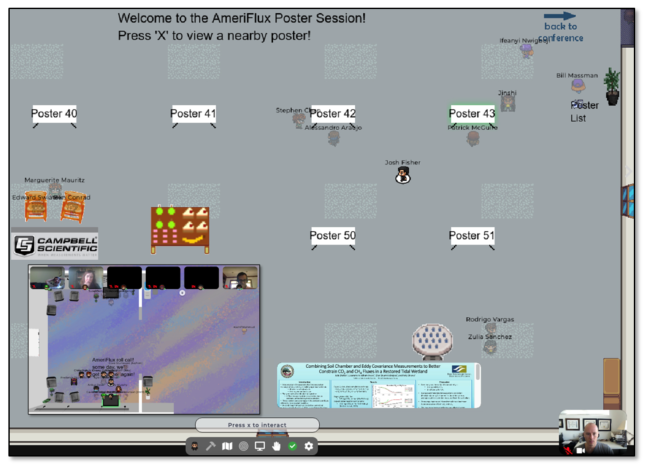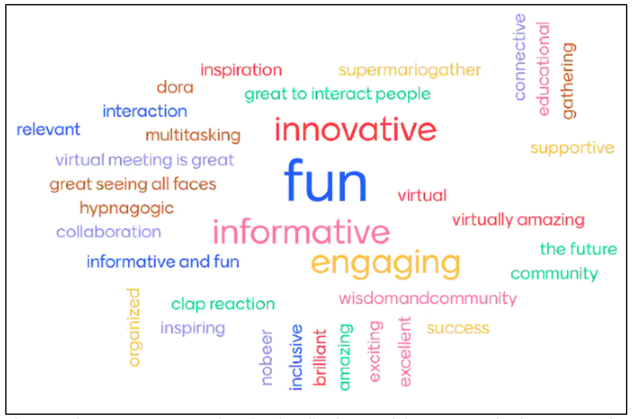The year 2020 brought new challenges with connecting scientists at large conferences, and the AmeriFlux Annual Meeting was no different. Faced with restrictions on travel and safety precautions, the organizers saw this challenge as an opportunity. Why not invite all of the Americas and make the focus on increased collaborations, mentoring and science communication?
The typical Annual Meeting of the past sized at ~80 participants and was largely in-person. This year the AmeriFlux Annual Meeting grew to 400+ registered and ~280 live participants with the ease of virtual conferencing and provided our community with an avenue to connect unlike ever before. With support from the AmeriFlux Management Project (AMP) and the US Department of Energy (DOE), the organization committee included:
- Sara Knox, Chair, University of British Columbia
- Jorge Perez-Quezada, Chair, University of Chile
- Gabriela Shirkey, Chair, Michigan State University
- Trevor Keenan, Lead, AMP LBNL
- Gil Bohrer, Core-site PI, The Ohio State University
- Benjamin Runkle, University of Arkansas
- John Frank, USDA
- Josh Fisher, NASA
- Christin Buechner, AMP LBNL
Together, AmeriFlux hosted a three-day event Oct. 6-8, 2020 featuring three sessions with plenary talks, career panels and mentoring opportunities for early career folks, breakout sessions and even a virtual social. Attendees used avatars in a virtual gaming-like environment called Gather, which enhanced connectivity and simulated a live conference. With free admission and easy accessibility, international scholars represented 35% of participants and 32 countries.

The virtual gaming environment of Gather for the AmeriFlux 2020 annual meeting facilitated scientific interactions, conversations, and side discussions important to in-person meetings, but that are often missing in virtual meetings. Here, a screenshot shows user-controlled avatars browsing and discussing the posters. The bottom-left inset shows scientists watching some field site videos as a group.
Three sessions “Bridging the Americas”, “Informing Decision Makers” and “Open Science” catered to our community’s growing interests and opportunities
Our conference titled “Bridging the Americas” brought together institutions from Brazil, Mexico, Canada, the US, Costa Rica and others for a session dedicated on recognizing relations and science across international institutions. Dr. Jorge Perez-Quezada chaired the featured session. Keynote Dr. Arturo Sanchez-Azofeifa of University of Alberta presented “A vision on the estimation of Photosynthetic Active Radiation (fPAR) using sensor networks”. Guest speakers Dr. Aurelio Guevara-Escobaralso and Dr. Enrico A. Yepez shared findings of water and carbon fluxes across Mexico and their respective initiatives to increase sampling and measure gradient variability.
Our community discussed engagement with stakeholders and our role in science policy in the session “Informing Decision Makers” chaired by Dr. Benjamin Runkle. AmeriFlux and FLUXNET research sites can offer great detail to inform critical decisions on land management, climate mitigation and more. Dr. Patty Oikawa of Cal State East Bay detailed her strategy on sharing wetland emissions to inform local carbon markets. Dr. Kim Novick of Indiana University discussed the politics of informing decision makers with examples of land-based climate mitigation in the Midwest. Dr. Gyami Shrestha joined us from the United States Carbon Cycle Science Program to present “Past to Future: A Vision for Diverse and Inclusive Carbon Cycle Science Collaborations” and encouraged us to share data for synthesis activity.
Hot topics in remote sensing, soil respiration and modeling were presented in the “Open Science” session, chaired by Dr. Sara Knox. Keynote speaker Dr. Ben Bond-Lamberty presented “Integrating large scale soil respiration and other datasets for understanding of global change” and ignited interest in community collection activities. Speakers Drs. Jingfeng Xiao and Xian Wang contributed insights on satellite mapping of photosynthesis via solar-induced cholorphyll fluorescence and enhancing measurements of dryland carbon uptake, respectively, while discussing the integration of FLUXNET observations.
With so many presenters and exciting topics, only a few were mentioned thus far. To view all the speakers and presentation titles, review the AmeriFlux Annual Meeting 2020 Agenda and the presenter’s abstracts.
Early Career networking at Career Panel and Mentor-Mixer left a lasting impact
The community prioritized early career engagement and mentorship and acknowledged that the pandemic highly-impacts the performance of students, postdocs and other early career researchers in the network (ECN). Two breakout sessions lead by ECN Organizers Gabriela Shirkey and Frederick Otu-Larbi were dedicated to making space for mentoring. The result connected leading scientists with many new faces in the ECN. Attracted by the free and virtual opportunity to meet with AmeriFlux leaders, the ECN group grew beyond the labs of FLUXNET PIs and collaborators, representing data modelers and remote sensors from around the globe interested in flux research.
Discussions varied from career stages, life decisions and barriers to achieving our goals as scientists. Experiences and dialogues included: (1) diversifying your mentors beyond the advisor; (2) keeping boundaries; (3) reflecting on what makes us happy; (4) breaking down harmful barriers; and (5) recognizing that where we end up may be different than what we aimed for in the beginning of our journey. The group presented their conversations in story-board format, featuring Dora the Explorer as a student researcher beginning her career:

A storyboard of the Early Career Network (ECN) Career Panel and Mentor Mixer discussion from the AmeriFlux Annual Meeting 2020 featuring Dora the Explorer.
We are grateful to the mentors who volunteered their experiences not only as scientists, but as individuals; and for their willingness to remain as mentors beyond the meeting. Early career researchers seeking mentors are encouraged to reach our to those listed below.
Our Career Panel featured guests from multiple institutions and specialties, including:
- Dr. Josh Fisher – Science Lead, ECOSTRESS Mission. Research Scientist, Carbon Cycle & Ecosystems Group. Jet Propulsion Laboratory. (https://science.jpl.nasa.gov/people/JFisher/)
- Dr. Sara Knox – Assistant Professor, Dept. of Geography, University of British Columbia (https://www.geog.ubc.ca/persons/sara-knox/)
- Dr. Sha Feng – Assistant Research Professor, Member of Graduate Faculty, Mentor of the Research Experiences for Undergraduates (REU) program in Climate Science in the Dept. of Meteorology and Atmospheric Science, PennState University (http://www.met.psu.edu/people/sxf39)
- Dr. Rodrigo Vargas – Associate Professor, Dept. of Plant and Soil Sciences, University of Delaware (https://udel.edu/~rvargas/Vargas/Home.html)
- Dr. Cove Sturtevant – Research Scientist, Instrumented Systems QA/QC Lead, NEON (https://www.neonscience.org/observatory/staff/cove-sturtevant)
The Mentor-Mixer allowed ECN guests to engage personally and in small groups with senior researchers, including:
- Dr. Mallory Barnes – Assistant Professor, Paul H. O’Neill School of Public and Environmental Affairs, Indiana University (https://oneill.indiana.edu/faculty-research/directory/profiles/faculty/full-time/barnes-mallory.html)
- Dr. Ankur Desai – Professor, Associate Chair of Graduate Studies, Dept. of Atmospheric and Oceanic Sciences, University of Wisconsin-Madison (https://aos.wisc.edu/faculty/Desai/)
- Dr. Jorge Pérez-Quezada – Professor, Dept. of Environmental Sciences and Renewable Natural Resources, Universidad de Chile (https://www.uchile.cl/portafolio-academico/perfilAcademico.jsf?username=jorgepq)
- Dr. Josh Fisher – Science Lead, ECOSTRESS Mission. Research Scientist, Carbon Cycle & Ecosystems Group. Jet Propulsion Laboratory. (https://science.jpl.nasa.gov/people/JFisher/)
- Dr. Cove Sturtevant – Research Scientist, Instrumented Systems QA/QC Lead, NEON (https://www.neonscience.org/observatory/staff/cove-sturtevant)
- Dr. Sha Feng – Assistant Research Professor, Member of Graduate Faculty, Mentor of the Research Experiences for Undergraduates (REU) program in Climate Science in the Dept. of Meteorology and Atmospheric Science, PennState University (http://www.met.psu.edu/people/sxf39)
AmeriFlux remains a growing network of inclusive scientists
Overwhelmingly, the event was a success. When asked if they would attend again, all participants responded “Yes”. Feedback congratulated the community on maintaining personal connections and cultivating a positive learning environment:
“I’ve been to three virtual conferences this year. The AmeriFlux conference was the best by far.”
“AmeriFlux, is a warm and inclusive organization. Virtual meetings can be quite robotic, but I still could feel that welcoming culture in this years AmeriFlux’s virtual meeting.”
Future meetings are encouraged to adopt hybrid environments and alter in-person and virtual opportunities to preserve the accessibility as well as the personal connections we create when together. In one word, participants shared what they felt about the meeting. Top of the list: ‘fun’. Can’t say we disagree!

